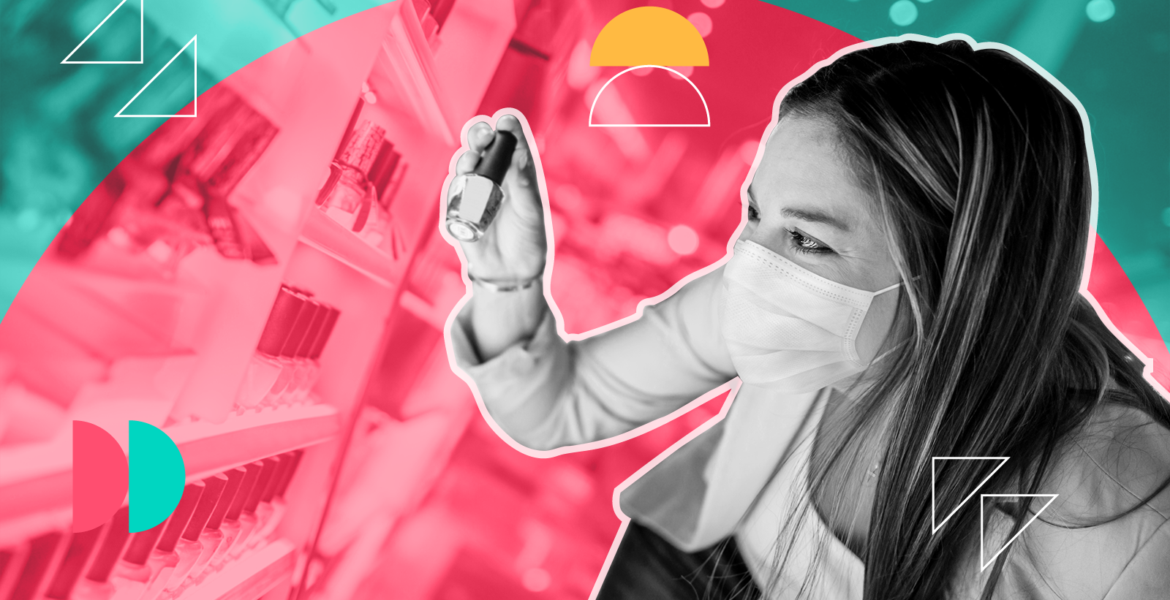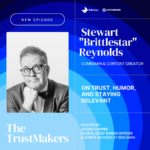By Mark Payne, CEO and Co-founder, Electric Innovation
A few nights back, I curled up with a whiskey for the annual ritual of cleaning up the pics on my phone. Purging old lists, dry cleaning tickets, receipts and the like. Organizing the stuff worth keeping.
Happily sucked into the swipe-stream of family milestones, food porn, jam bands, ballgames with my son and cool grabs of Brooklyn graffiti, I was at it for an hour when I found the oddity below.
 At first I couldn’t remember what it was or why I’d stopped to capture it.
At first I couldn’t remember what it was or why I’d stopped to capture it.
But then I checked the date and it all came back.
It was March of 2020. A morning rush hour airport security line. Normally a dreaded, swarming queue on a jampacked day trip from New York to Atlanta to see a client at Coca-Cola, through the meatgrinder of two of the most crowded airports on Earth. That morning, I could count the crowd in the security line on one hand.
The front page of that morning’s New York Times said the U.S. COVID case count had reached a whopping 500, spread across 38 states. Not enough to fill a high school gym. My colleague and I had convinced our families that the odds of getting sneezed on by the wrong guy seemed negligible. It would be our last business trip for two Zoom-y years.
Swiping away on the couch, my first thought was, “thank God, all that’s behind us.” At least for the lucky slice of us who hadn’t said farewell to loved ones in that awful chapter.
But taking stock of the innovation work I do all day I realized the degree to which—even five years later—COVID’s effects are still shaping the innovation agenda for so many companies.
It’s the innovator’s version of what the doctors call long COVID. The lingering effects. The “not yet back to normal.” Not on a body, of course, but on a culture. Big shifts deeply rooted in the COVID-era that are continuing to shape the human needs every innovator obsesses about.
Here are three shifts that stand out.
Premiumization > Affordability
Before Covid, most of my clients across the Fortune 500 were obsessed with premiumization. Innovating their way to higher price points and margins through leaps in function, design, or all of the above.
That appetite for premiumization will never go away, but today there’s a new obsession with innovations that unlock affordability. Consumers are squeezed. Look no further than that longtime benchmark of value, Subway’s famous five-dollar footlong sandwich. It’s seven bucks now. Look at Apple aiming innovation at cheaper, entry-level iPhone models.
Even solid earners with six-figure household incomes find themselves cash-strapped in the face of spiking mortgage rates, rents, insurance bills, healthcare and groceries. Many beloved brands that long considered themselves bulletproof are now being ravaged by the unprecedented contraction of discretionary categories and the onslaught of private label. Brands long considered staples are suddenly recast as discretionary luxuries.
Earning a place in a shrinking market basket has to move from the periphery to the heart of the innovation agenda. It’s the only way forward.
The pain of the inflationary cycle is by now so embedded that we forget it was set in motion by COVID’s supply chain disruptions. The pressing need to aim innovation at affordability is a COVID legacy.
Individualism > Isolation
Pre-COVID, we were living in a golden age of individualism. Personalization seemed to be on every client’s innovation wish list (even in categories where it doesn’t make sense as a business model). Self-expression was king. The march of social media ever deeper into daily life made the celebration of self a rampant obsession.
There was a less celebratory undercurrent to it—people spending more time alone, fueled by the way digital pursuits like cruising social feeds, gaming and binge watching (and, yes, ubiquitous porn) made spending time alone more fun than it used to be. The shift was most acute among teens and young adults—historically the most socially-active slice of humanity.
The pandemic lockdowns—arguably the biggest social experiment in human history—created a profound tipping point where the joy of individualism morphed into epic loneliness. Shutting us off from the live interaction with colleagues, fellow students and neighbors that’s as vital to human beings as air, food and water. And when the lockdowns lifted, it wasn’t like a switch was thrown to get us social again. Social muscles had atrophied. Even now they aren’t what they were.
Fast forward a few years and loneliness is dominating the conversation as an epidemic in its own right. Former U.S. Surgeon General Vivek Murthy warned of the dangers of isolation, calling in his parting prescription for the country to choose “community as the irreplaceable foundation for our well-being.” Airbnb founder Brian Chesky has voiced the same concerns, and realized his platform sits squarely in the “togetherness” business. More companies should follow his lead and double down on their roles in the future of togetherness.
The noisiest tech innovations playing out now are making the situation worse, not better. Tristan Harris, founder of the Center for Humane Technology, reported on his podcast last month that over 20 million young people now spend five-plus hours a day in deep intimate, personal and often sexual conversations with AI chat bots. When asked why, many users report that the bots understand them better than their real friends. Horrified? We should be.
There’s a call to action all innovation leaders need to heed. It’s time to steer innovation toward bringing people out of their cloistered rooms and back together in the world. The cost of not doing that will be hard to measure.
Structure > Fluidity
Pre-Covid life for many of us was highly structured.
The boundaries between work time and personal time had already begun to fray, but we still craved that separation. Along came a countermovement pushing back against the ‘always on’ mode. The message was unsubtle—give us back the old structure, please, where a workday had a clean beginning and a clean break point at the end.
The gravitational pull toward structure manifested itself across many industries. The beauty business, for example, saw consumers take on increasingly complex skin care regimens, and adhere to them religiously, taking great pride in sharing their braggably over-the-top daily rituals.
Fast forward to post-COVID reality and you might say structure is on the run.
The beauty market has pivoted hard from rigidity into wild experimentation. Exclusive prestige brands like Fenty and Drunk Elephant have built entirely new product lines of miniature sizes, purpose-built to make fleeting appearances in a consumer’s routine, focused on getting into the rotation rather than on chasing regular use.
Multiple studies show brand loyalty trending down hard and at an all-time low across an array of categories.
Ways of working are part of this shift away from structure. The number of U.S. workers working from home for at least part of the week surged from a baseline of 7% to 28% in COVID’s wake. For many, flexible work was embraced like the arrival of Social Security, Medicare or Obamacare – as a new entitlement. The history of entitlements says once we get a taste of a new one, we don’t want to give it up. Companies and governments are pulling hard to get us back to the office, but many workers are voting with their feet – opting to quit, rather than return to that old, rigidly-structured work week.
Work tools like Slack (which I’ll confess I’m merrily addicted to) have surged in popularity, in part because topic-based conversation systems make it far more efficient for a fluid, remote team to keep up with each other, peek in any time to catch up on what they missed and collaborate in real time or asynchronously. It’s fluidity on crack.
How should innovators think differently in this fluid world? Pre-Covid, we tended to look at innovation as a way to displace competitors in a binary, zero sum game. This more fluid world calls for a different mindset. An additive view. Asking how we can earn a complementary role in the ever-expanding repertoire of a promiscuous, non-committal post-Covid consumer, improvising day to day.











